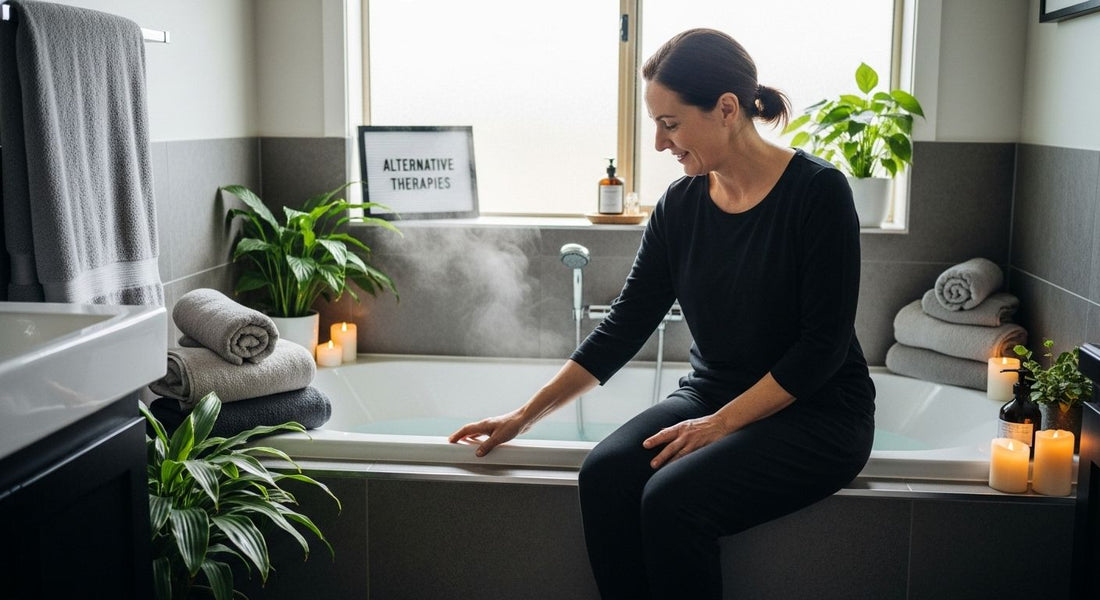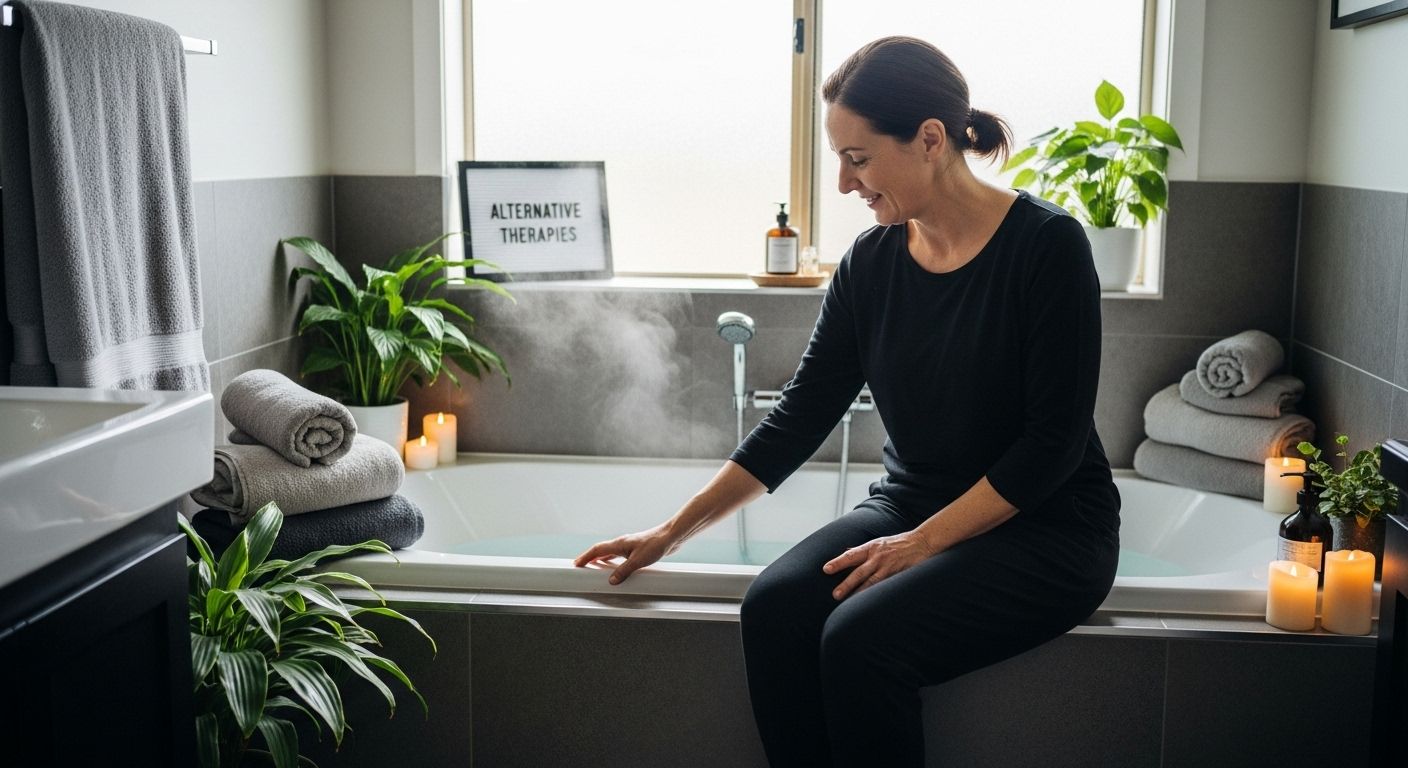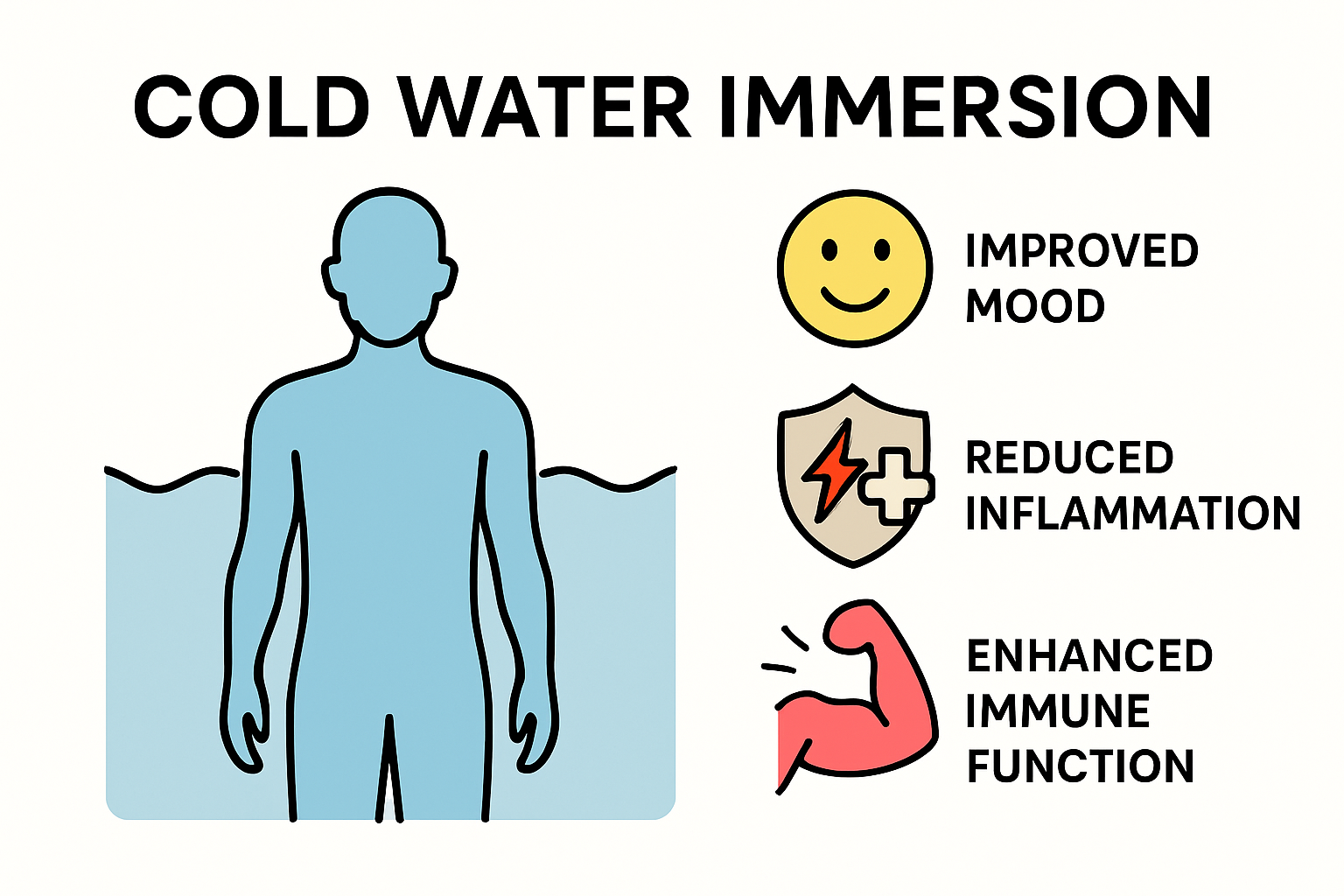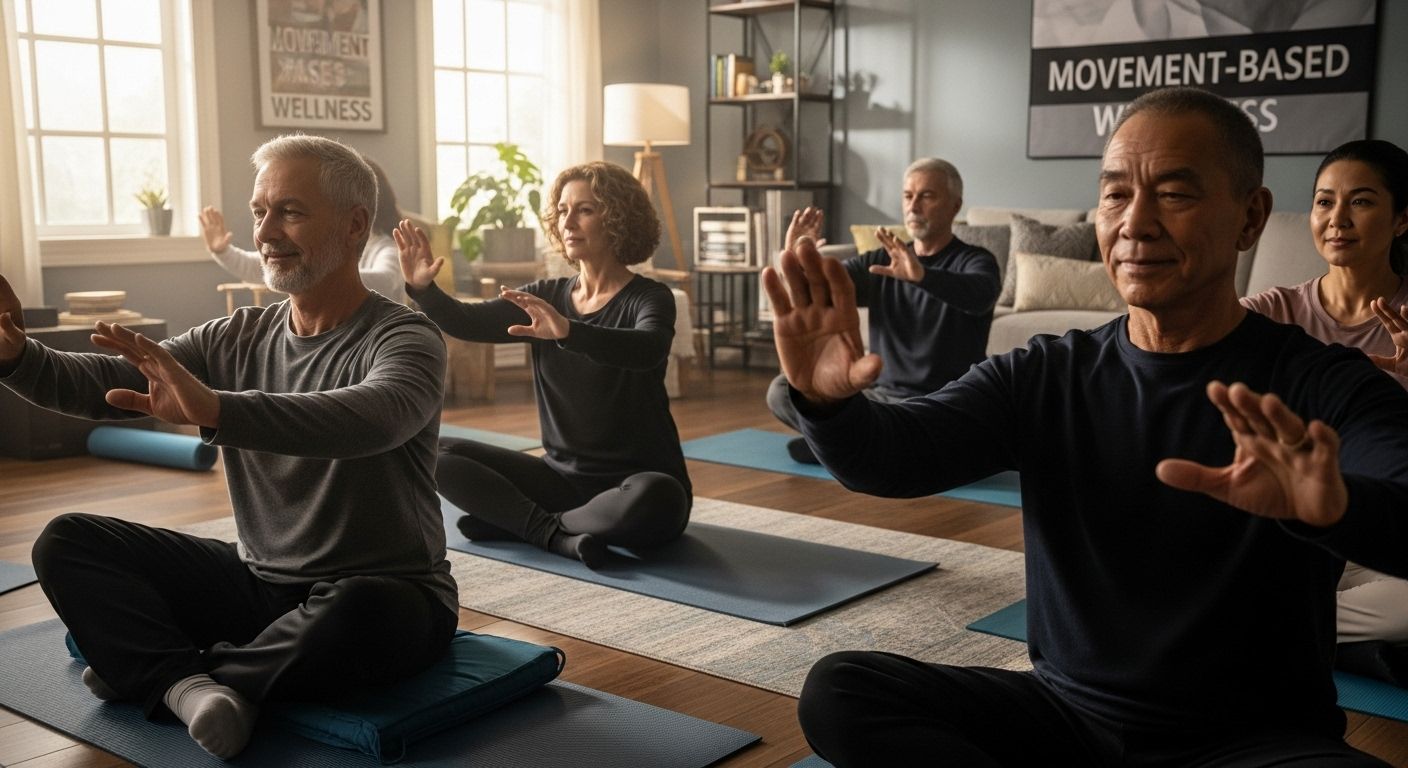
Top Alternative Therapies to Sauna for Relaxation at Home

Everyone knows the deep sweat of a sauna can melt stress and tension, but not everyone has access to one at home. Surprise twist. Immersing yourself in hot water can actually deliver recovery benefits that rival aerobic workouts, with studies noting significant boosts in insulin sensitivity. Some of the most powerful relaxation therapies go way beyond steamy rooms and can fit right into your daily routine.
Table of Contents
- Exploring Popular Non-Sauna Thermal Therapies
- Cold Water Immersion and Its Health Benefits
- Breathwork and Meditation for Deep Relaxation
- Integrating Alternative Wellness Solutions at Home
Quick Summary
| Takeaway | Explanation |
|---|---|
| Hot water immersion boosts recovery. | Immersing in hot water enhances muscle recovery and insulin sensitivity, making it ideal for athletes. |
| Cold water immersion aids mental health. | Regular cold exposure improves mood, reduces stress, and helps build psychological resilience. |
| Combine breathwork and meditation for enhanced relaxation. | Integrating these techniques effectively lowers stress hormones and induces a state of calm. |
| Aromatherapy can enhance emotional well-being. | Using essential oils like lavender can alleviate anxiety and improve sleep quality. |
| Movement practices improve overall wellness. | Techniques like Tai Chi Chuan combine movement and breath, reducing stress and enhancing mood. |
Exploring Popular Non-Sauna Thermal Therapies
Thermal therapies offer powerful alternatives to traditional saunas for individuals seeking relaxation and health benefits from heat-based treatments. While saunas remain popular, several accessible home-based thermal therapy options can provide similar physiological advantages without requiring specialized equipment.
Hot Water Immersion Therapy
Hot water immersion represents a remarkably effective alternative therapy for those seeking thermal relaxation. Research published in the National Institutes of Health demonstrates that regular thermal therapy can significantly improve insulin sensitivity and enhance endothelial nitric oxide synthase expression. These physiological responses are comparable to the benefits achieved through aerobic training.
Specifically, hot baths at carefully controlled temperatures can trigger multiple health benefits. Scientific studies from cardiovascular research centers have shown that hot water immersion at approximately 40.6°C, when combined with light resistance exercise, can increase voluntary muscle strength and accelerate recovery from physical fatigue. This makes hot baths an attractive option for athletes and individuals seeking muscle recovery strategies.
Heating Pad and Localized Heat Therapy
For those unable to immerse their entire body in hot water, localized heat therapy using heating pads offers a convenient alternative. These devices allow targeted heat application to specific muscle groups or areas experiencing tension or discomfort. The concentrated warmth helps improve blood circulation, reduce muscle stiffness, and promote relaxation without requiring full-body immersion.
Heating pads come in various sizes and technological configurations, ranging from traditional electric models to advanced infrared options. Users can adjust temperature settings to customize their therapeutic experience, making this approach highly adaptable to individual comfort levels and specific wellness needs.
Advanced Thermal Recovery Techniques
Beyond traditional methods, emerging thermal therapy techniques are expanding the landscape of heat-based relaxation. Cutting-edge research exploring heat therapy’s impact on health suggests that strategic heat exposure can potentially improve glucose metabolism and cardiovascular function. These findings indicate that thermal therapies might offer broader health benefits than previously understood, potentially supporting cognitive function and addressing age-related physiological changes.
Interesting emerging techniques include contrast therapy, where individuals alternate between hot and cold treatments to stimulate circulation and enhance recovery. This method, often used by athletes and physical therapists, demonstrates the versatility of thermal therapies beyond traditional sauna experiences.
While these alternative therapies provide excellent options for home-based relaxation, individuals with pre-existing health conditions should always consult healthcare professionals before initiating any new thermal therapy regimen. Temperature, duration, and individual health status play crucial roles in determining the safety and effectiveness of these approaches.
Thermal therapies represent a flexible, accessible approach to wellness that can be easily integrated into home wellness routines. By understanding the diverse options available beyond traditional saunas, individuals can create personalized relaxation strategies that align with their specific health and comfort preferences.
Here is a comparison table summarizing the key features, benefits, and unique considerations of the main non-sauna thermal therapies discussed in this section.
| Therapy Type | Main Benefit | Key Features / Application | Notable Considerations |
|---|---|---|---|
| Hot Water Immersion | Muscle recovery, insulin sensitivity | Full/body immersion, 40.6°C, home baths | Consult healthcare pro if health issues |
| Heating Pad / Localized Heat | Targeted muscle relaxation | Specific muscle groups, adjustable settings | Easy to use, suitable for localized needs |
| Contrast Therapy | Circulation, recovery | Alternate hot & cold, enhances recovery | Emerging, popular with athletes |
| Advanced Thermal Recovery Techniques | Glucose metabolism, cardiovascular | Strategic heat exposure, research-driven | May address age-related changes |
Cold Water Immersion and Its Health Benefits
Cold water immersion has emerged as a powerful alternative therapy offering remarkable health benefits that extend far beyond traditional relaxation techniques. This practice involves strategic exposure to cold water, which triggers significant physiological responses that can enhance overall wellness and mental resilience.
Mental Health and Stress Reduction
Research published in the International Journal of Circumpolar Health reveals compelling evidence about cold water immersion’s profound impact on mental wellbeing. Studies demonstrate that regular cold water exposure can substantially improve mood, reduce stress levels, and potentially enhance cardiovascular function. The body’s natural response to cold water stimulates the production of endorphins and norepinephrine, neurotransmitters that play crucial roles in mood regulation and stress management.
Moreover, scientific investigations in the journal Temperature indicate that cold water immersion can alleviate symptoms of depression and anxiety. The controlled stress introduced by cold water helps build psychological resilience, training the nervous system to respond more effectively to challenging situations.
Physical Recovery and Inflammation Management
Athletes and fitness enthusiasts have long recognized cold water immersion as an exceptional recovery strategy. The physiological mechanisms triggered by cold exposure help reduce muscle inflammation, accelerate healing processes, and minimize post-exercise soreness. When muscles are exposed to cold temperatures, blood vessels constrict, which helps flush out metabolic waste and reduce swelling.
Cold water therapy creates a unique environment for rapid muscle recovery. By strategically lowering body temperature, individuals can experience reduced muscle damage, faster healing of micro-tears caused by intense physical activity, and improved overall recovery times. This makes cold water immersion an attractive alternative for those seeking efficient post-workout restoration.
Immune System Enhancement
Beyond mental and physical recovery, cold water immersion demonstrates promising potential in strengthening immune function. The controlled stress induced by cold exposure stimulates the body’s natural defense mechanisms, potentially increasing white blood cell count and improving overall immune response. Regular practitioners report fewer instances of common illnesses and enhanced metabolic efficiency.
It is crucial to approach cold water immersion with proper knowledge and gradual adaptation. Beginners should start with shorter exposure times and gradually increase duration. Individuals with pre-existing health conditions, particularly cardiovascular issues, should consult healthcare professionals before initiating any cold water therapy regimen.
While cold water immersion offers numerous benefits, it represents a holistic approach to wellness that requires patience, consistency, and mindful practice. By understanding the intricate physiological responses triggered by cold exposure, individuals can unlock a powerful tool for physical and mental rejuvenation. The key lies in approaching this therapy with respect for one’s body and a commitment to gradual, sustainable progress.

Breathwork and Meditation for Deep Relaxation
Breathwork and meditation represent powerful alternative therapies for achieving deep relaxation and managing stress without the need for specialized equipment or physical intervention. These practices offer accessible, scientifically validated methods for individuals seeking mental and physiological restoration in the comfort of their own homes.
The Science of Breath Control
Research from Harvard Medical School reveals that structured breathing techniques can effectively activate the body’s natural relaxation response. By engaging specific breathing patterns, individuals can significantly reduce stress hormones, lower heart rate, and decrease blood pressure. This physiological reset provides a powerful mechanism for counteracting the harmful effects of chronic stress.
Breath control techniques work by directly influencing the autonomic nervous system. Slow, deliberate breathing patterns signal the body to transition from a sympathetic (fight-or-flight) state to a parasympathetic (rest-and-digest) state. This fundamental shift creates an immediate sense of calm and enables the body to enter a more balanced, relaxed condition.
Meditation Practices for Comprehensive Wellness
According to the National Center for Complementary and Integrative Health, meditation offers a comprehensive approach to relaxation that extends beyond simple stress reduction. Clinical studies consistently demonstrate meditation’s ability to promote psychological balance, enhance emotional regulation, and improve overall mental well-being.
Different meditation techniques provide unique benefits. Mindfulness meditation encourages present-moment awareness, helping practitioners detach from racing thoughts and reduce anxiety. Guided visualization meditation allows individuals to create mental landscapes of tranquility, offering emotional reprieve from daily stressors. Loving-kindness meditation focuses on cultivating compassion, which can significantly improve emotional resilience and interpersonal relationships.
Integrated Breathwork and Meditation Strategies
A comprehensive review published in the National Institutes of Health highlights the synergistic potential of combining breathwork and meditation. When practiced together, these techniques can produce profound relaxation effects that go beyond individual practices. The integrated approach helps decrease physiological arousal, lower blood pressure, and improve autonomic nervous system balance.
Beginners can start with simple techniques like diaphragmatic breathing paired with basic meditation practices. A typical session might involve finding a quiet space, sitting comfortably, and focusing on slow, rhythmic breathing while allowing thoughts to pass without judgment. As practitioners develop consistency, they can explore more advanced techniques and longer meditation durations.
While breathwork and meditation are generally safe, individuals with pre-existing mental health conditions or severe anxiety should consult healthcare professionals before beginning a new practice. The key to success lies in consistent, patient practice and an openness to exploring different techniques that resonate personally.
Breathwork and meditation offer a holistic, empowering approach to relaxation that requires nothing more than intentional focus and a commitment to personal well-being. By understanding and practicing these techniques, individuals can develop powerful tools for managing stress, enhancing mental clarity, and cultivating inner peace.
Integrating Alternative Wellness Solutions at Home
Creating a holistic wellness environment at home involves strategically combining multiple alternative therapies to enhance overall physical and mental well-being. By understanding and implementing diverse wellness approaches, individuals can transform their living spaces into personal sanctuaries of health and relaxation.
Aromatherapy and Essential Oil Integration
Research from the National Institutes of Health highlights aromatherapy as a powerful wellness tool. Essential oils, particularly lavender, demonstrate remarkable potential in alleviating psychological symptoms such as anxiety, depression, and sleep disorders. The US Food and Drug Administration recognizes many essential oils as generally safe, making them accessible home wellness solutions.
Effective aromatherapy implementation involves strategic oil selection and application methods. Diffusers can distribute therapeutic essential oil molecules throughout living spaces, creating environments that support relaxation and emotional balance. Different oils serve specific purposes: lavender promotes calmness, peppermint enhances mental clarity, and eucalyptus supports respiratory health.
Movement-Based Wellness Practices
Scientific studies published in medical research journals demonstrate that movement-based therapies like Tai Chi Chuan and Qigong offer comprehensive wellness benefits. These practices integrate physical movement, breath control, and meditative techniques to improve mood regulation, reduce stress, and enhance overall physiological functioning.
Home practitioners can create dedicated spaces for these gentle movement practices. A clear area with minimal furniture, soft flooring, and natural lighting provides an ideal environment for practicing these mindful movement techniques. Beginners can start with online tutorials or guided video sessions that break down complex movements into manageable sequences.

Comprehensive Relaxation Technique Integration
UCLA Health research emphasizes the importance of incorporating multiple relaxation techniques to stimulate the parasympathetic nervous system. Techniques like diaphragmatic breathing, visualization, and progressive muscle relaxation can be seamlessly integrated into daily routines to reduce stress and muscle tension.
Designing a dedicated wellness corner at home can facilitate consistent practice. This space might include comfortable seating, soft lighting, noise-canceling elements, and minimal distractions. Individuals can establish a routine that combines different relaxation methods, such as starting with breathwork, transitioning to gentle stretching, and concluding with guided meditation.
Successful home wellness integration requires personalization and experimentation. What works perfectly for one individual might need modification for another. Patience, consistency, and an open mindset are crucial in developing a sustainable wellness practice.
The following summary table highlights the benefits and distinguishing features of prominent movement-based wellness practices and relaxation techniques for home integration, as discussed in the respective sections.
| Practice / Technique | Main Benefit | Unique Features | Ideal Home Setup |
|---|---|---|---|
| Tai Chi Chuan / Qigong | Reduces stress, enhances mood and physiology | Integrates movement, breath, meditation | Open, clear space, soft flooring |
| Aromatherapy with Essential Oils | Alleviates anxiety, improves sleep | Diffusers, oils like lavender, peppermint, eucalyptus | Calm space, diffuser use |
| Diaphragmatic Breathing | Stimulates relaxation response | Can be integrated into routines, no equipment needed | Quiet, comfortable seating |
| Visualization / Progressive Muscle | Reduces muscle tension, calms mind | Focused mental imagery, step-by-step muscle relaxation | Wellness corner, minimal distraction |
By thoughtfully combining alternative therapies like aromatherapy, movement practices, and targeted relaxation techniques, individuals can create comprehensive wellness environments that support physical health, emotional balance, and mental resilience. The key lies in understanding personal needs, exploring various approaches, and developing a holistic strategy that evolves with changing lifestyle demands.
Frequently Asked Questions
What are some effective alternatives to sauna for relaxation at home?
Several effective alternatives to sauna for relaxation at home include hot water immersion therapy, localized heat therapy with heating pads, cold water immersion, breathwork, meditation, and aromatherapy. Each method offers unique benefits for stress relief and overall wellness.
How does hot water immersion therapy compare to sauna bathing?
Hot water immersion therapy can provide similar relaxation benefits as sauna bathing, including increased muscle recovery and improved insulin sensitivity. Regular hot baths at controlled temperatures can also promote cardiovascular health, making it an effective home alternative.
What are the benefits of cold water immersion?
Cold water immersion offers numerous health benefits, including improved mood, reduced stress, enhanced physical recovery, lower inflammation, and a stronger immune response. Regular practice can help build psychological resilience and promote overall wellness.
How can I integrate breathwork and meditation into my daily routine?
To integrate breathwork and meditation into your routine, start with simple diaphragmatic breathing techniques to relax. Set aside quiet time each day to practice mindfulness or guided visualization meditation, gradually increasing duration and complexity as you become more comfortable.
Discover Home Wellness That Goes Beyond Sauna Alternatives
Tired of trying to recreate the sauna experience with hot baths, heating pads, or complex relaxation routines? While the article highlights several practical therapies for relaxation at home, nothing truly compares to the deep, lasting comfort of a genuine sauna or hot tub. If you are serious about elevating your recovery and daily wellbeing, now is the perfect moment to explore premium solutions proven to deliver real results.

Upgrade your home with a modern sauna, hot tub, or cold plunge and feel the difference that real thermal therapy makes. Our wellness collection at Best Life Sauna is designed for people who want more than temporary relaxation. You deserve fast shipping, exclusive deals, and a wellness investment that supports your goals every day. Visit Best Life Sauna now and start transforming your routine with the best solutions on the market.

